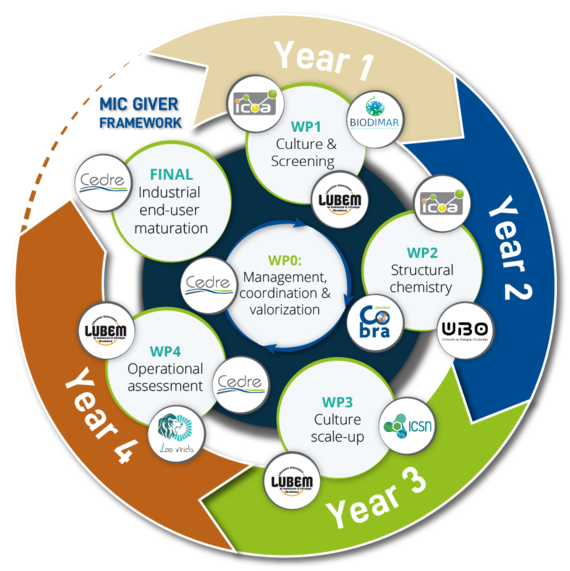MICromycete tarGeted bIotechnological Valorizations for Environmental bioRemediation
The Mic GIVER project aims at exploring the biotechnological potential of micromycetes for the bioremediation of 4 groups of various emblematic HNS (Hazardous and Noxious Substances):
- Glyphosate and AMPA (AminoMethyl Phosphonic acid),
- Picric acid (2,4,6-trinitrophenol),
- Diesel,
- Waxes (n-C10 to n-C20).
These HNS represent a persistent threat in all the environmental compartments either directly or through their degradation byproducts. Moreover, according to their lifetime histories and their inherent physicochemical properties, their behaviour in impacted environments calls for specific clean-up methods. Bioremediation is a green clean-up or response method using natural or biotechnologically engineered living organisms selected for their capacities to degrade and/or accumulate HNS in situ. Plants, fungi, and bacteria have proven to be effective enough to partially or totally decontaminate heavily impacted environments (e.g. by heavy metals, oil spills). Bioremediation is generally implemented through 2 distinct strategies:
- bioaugmentation whereby an allogenic decontaminating organism or consortium is inoculated in the environment. These organisms can be wild or genetically modified for depollution purposes and must be selected with a sufficiently strong fitness level and be stable enough to survive, multiply and diffuse in an unfriendly environment where the competition for resources with autochthonous organisms can be fierce
- biostimulation where the depolluting abilities of native organisms are stimulated artificially by adding nutrients, improving aeration or increasing the bioavailability of pollutants (e.g. dispersing agents on oil). The literature estimates that only 10% of the microflora of an impacted environment can present degradation activity for a given common pollutant. Thus, the objective of biostimulation will be to boost this ability by changing the physicochemical properties of the environment without negatively weighing down the degree of NEBA (Net Environmental Benefit Analysis).
Compared to other bioremediation organisms, fungi have a recognized but as yet underexploited potential. This paradox is reinforced given the limits of other “competing” methods, e.g. the evanescence of bacterial bioaugmentation caused by competitive-exclusion by native microbiota during oil spills or the use of invasive plants (e.g. Spartina alterniflora) for phytoremediation of polluted sites in China. The most relevant approaches to effectively exploit the bioremediation fungal potential are:
- Screening for specific bioremediation activities of targeted HNS
- Optimizing cultivation protocols of decontaminating fungi
- Improving control of the bioremediation process.
Our research hypotheses perfectly fit with these approaches. We assume that the knowledge of the global fungal metabolome and proteome is still in its early stages, thus depriving us of a huge diversity of biomolecules with structure-function relationships of unsuspected value. We think that the efficiency of decontamination processes could be dramatically increased and controlled using integrative strategies through the use, for example, of well-controlled upstream culture methods or by pinpointing unsuspected synergies between fungal remediation and other bioremediation strategies like phytoremediation.
We will adapt existing bioremediation protocols to fungal bioremediation (bioaugmentation and biostimulation) according to various pollution scenarios and realistic operational procedures for in situ application.
At the end of the project, we propose two main deliverables (TRL 8):
o A screened biological collection of fungi immediately available on an industrial scale for pollution control activities on the four reference HNS. This screening includes confirmed direct biodegradation activities or indirect biodegradation activities by improving the bioavailability of pollutants (e.g. mycosurfactant production).
o An in situ mycoremediation operational guide on the four reference HNS according to specificities of potentially different impacted environments.

